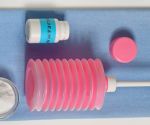Advertisement
The purpose of an orgasm isn't solely to make you feel good. The biological purpose is to better the odds that this union between sperm and egg takes place.
On the woman's side, the mucous membranes that line the vaginal walls release fluids during intercourse so that the penis can slide with just the right amount of friction. As intensity and sensations build, the woman's brain tells the vagina and nearby muscles to contract. That contraction brings the penis in deeper and increases the chance of his sperm getting closer to the target. During an orgasm, the cervix, located at the top of the vagina, dips down like an anteater, and sucks semen in the cervix (the bottom of the uterus). The sperm is trapped in the cervical mucus until the release of the egg, and a signal then lets the sperm start the competitive swim up into the uterus.
On the woman's side, the mucous membranes that line the vaginal walls release fluids during intercourse so that the penis can slide with just the right amount of friction. As intensity and sensations build, the woman's brain tells the vagina and nearby muscles to contract. That contraction brings the penis in deeper and increases the chance of his sperm getting closer to the target. During an orgasm, the cervix, located at the top of the vagina, dips down like an anteater, and sucks semen in the cervix (the bottom of the uterus). The sperm is trapped in the cervical mucus until the release of the egg, and a signal then lets the sperm start the competitive swim up into the uterus.

More About this Book
YOU: Having a Baby: The Owner's Manual to a Happy and Healthy Pregnancy
Can I get a cavity filled while pregnant? Will avoiding spicy foods make my kid a picky eater? Can I really increase my baby's IQ while she's in utero? Whether you're pregnant for the first time,...
Continue Learning about Gynecology
Important: This content reflects information from various individuals and organizations and may offer alternative or opposing points of view. It should not be used for medical advice, diagnosis or treatment. As always, you should consult with your healthcare provider about your specific health needs.






